Leaky gutter corners can be a major headache for Auckland homeowners, especially given the city’s frequent rainfall, high humidity, and coastal conditions. If left unchecked, these leaks can lead to water damage, peeling paint, mold growth, and even foundation issues, potentially costing thousands in repairs. Whether you’re in West Harbour, Mt Eden, or Papakura, fixing gutter corner leaks is a crucial part of roofline maintenance to protect your home, maintain its curb appeal, and ensure its structural integrity.
At My Homes Construct Ltd, we’ve been helping Aucklanders with gutter repairs for over 10 years, and we’ve seen firsthand how addressing leaky gutter corners can save homeowners from costly damage. In this comprehensive guide, we’ll walk you through the causes of gutter corner leaks, how to spot them, and a detailed step-by-step process to fix them yourself. We’ll also share case studies, preventative maintenance strategies, pro tips tailored for Auckland’s unique weather challenges, and advice on when to call in the experts. Let’s get your gutters watertight and your home protected for the long haul!
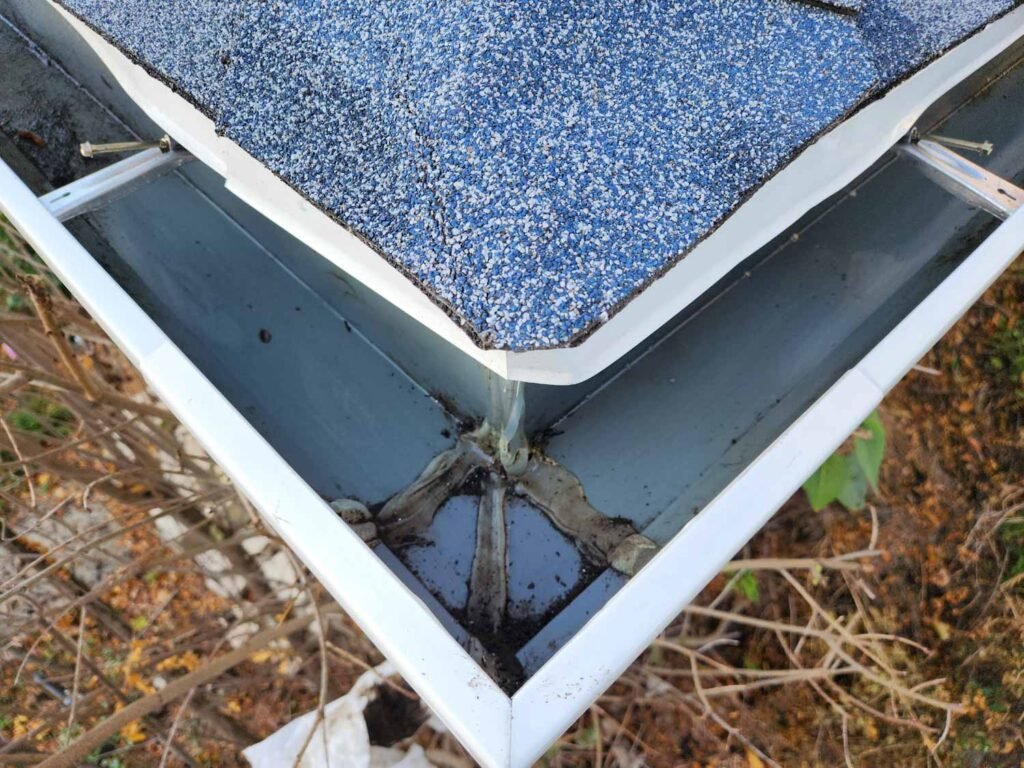
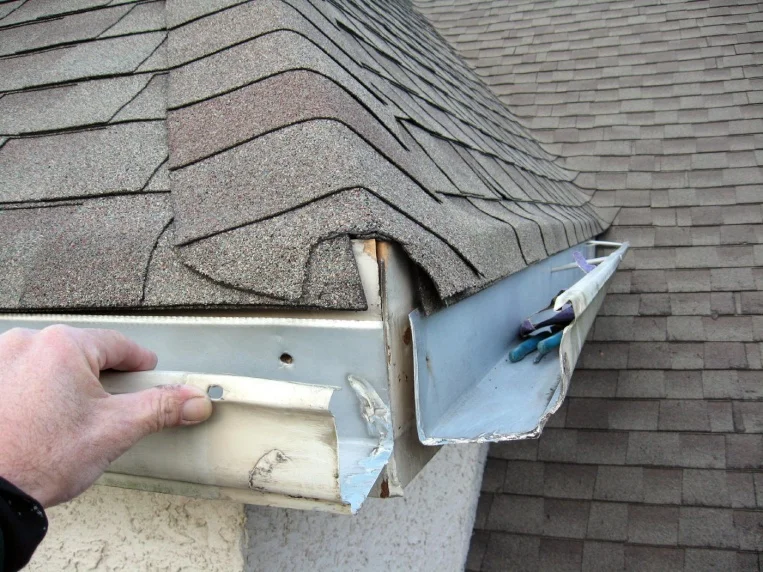
Understanding the root causes of leaky gutter corners can help you prevent future issues and ensure a lasting repair. Here are the most common culprits in Auckland homes, where the climate and environment play a significant role.
Over time, the sealant used to waterproof gutter corner joints breaks down due to exposure to UV rays, temperature fluctuations (ranging from 10°C in winter to 25°C in summer), and Auckland’s high humidity (70-80% year-round, per NIWA). Most sealants, like silicone or rubberized compounds, have a lifespan of 5-10 years. Once they degrade, cracks form, allowing water to seep through the joints. A client in Henderson we worked with had 15-year-old gutters with cracked sealant—reapplying a fresh layer of silicone-based sealant fixed their leaks and extended the life of their gutter system by another decade.
If gutters were installed incorrectly or the corner joints weren’t properly sealed during installation, leaks can develop over time. Loose or misaligned joins can also pull apart due to thermal expansion (common in Auckland’s fluctuating temperatures) or wind stress in the city’s high-wind zones (up to 44m/s under NZS 3604). Poorly installed gutters are a common issue in older homes or DIY installations. In Papakura, we repaired a client’s gutter corners that were leaking due to poor initial installation—tightening the joins and resealing them with a high-quality sealant solved the issue and prevented further leaks.
Blocked downpipes can cause water to back up and overflow at the corners, putting extra pressure on the joints and leading to leaks. In Auckland, where annual rainfall averages 1,200mm, debris like leaves, twigs, pollen, or even silt from urban pollution can clog downpipes, especially in treed areas like Titirangi or Albany. This overflow can erode sealant and widen gaps in the corner joints. A client in St Heliers had corner leaks caused by a blocked downpipe filled with leaves—we cleared the blockage, cleaned the gutters, and sealed the joints, preventing further overflow and damage.
Auckland’s weather can be tough on gutters, with heavy rain (up to 150mm in a single day during winter storms) and strong winds causing significant wear and tear. Coastal areas like West Harbour, Mission Bay, or Takapuna also face salt exposure from sea air, which can corrode metal gutters and weaken corner joints over time. Repeated exposure to these elements can cause seams to separate, rust to form, or sealant to crack, leading to leaks. In Mission Bay, we fixed a client’s rusty gutter corners damaged by salt air, using a rust-resistant sealant and applying a protective coating to ensure a long-lasting repair.
Auckland’s temperature swings, while not extreme, can still cause gutters to expand and contract, especially in aluminum or steel systems. Over time, this movement can loosen corner joints or crack sealant, particularly if the original installation didn’t account for expansion gaps. In Remuera, we repaired a client’s gutter corners that had separated due to thermal expansion—adding a flexible silicone sealant accommodated the movement and stopped the leaks.
Spotting a leaky gutter corner early can save you from costly water damage and structural issues. Here are the key signs to look for in your Auckland home, where the wet climate can exacerbate these problems.
If you notice water dripping from the gutter corners during or after rain, it’s a clear sign of a leak. Check the corners after a typical Auckland downpour—dripping indicates that the joint isn’t watertight and water is escaping. A client in Mt Roskill noticed dripping after a storm—we sealed their gutter corners with a silicone-based sealant, stopping the leak before it caused further damage to their fascia.
Water escaping from leaky gutter corners can run down your fascia, soffits, or siding, causing paint to peel, bubble, or flake. This is a common issue in Auckland’s humid climate, where moisture accelerates paint deterioration and can lead to wood rot if untreated. If you see peeling paint below your gutters, inspect the corners for leaks immediately. In Epsom, we helped a homeowner address peeling fascia paint caused by a leaky corner—fixing the leak and repainting the fascia restored their home’s exterior and prevented further rot.
Leaking gutter corners can cause water to spill over and pool around your home’s foundation, leading to potential structural damage over time. In Auckland, where heavy rain is frequent, this can erode soil, cause foundation cracks, or even lead to basement flooding, with repair costs ranging from $5,000 to $15,000. A client in Papakura noticed pooling water near their foundation after a storm—we repaired their gutter corners and redirected the downpipe to a drainage area, preventing further issues and protecting their foundation.
If your gutters are metal (e.g., aluminum or steel), rust around the corner joints is a sign of prolonged moisture exposure, often due to leaks. Rust weakens the metal, making it more prone to cracking or breaking. You might also see visible gaps or cracks in the seams where the sealant has failed or the joint has separated. In West Harbour, we fixed a client’s rusty gutter corners by removing the rust with a wire brush, sealing the joints with a rust-resistant sealant, and applying a protective coating to prevent future corrosion.
In Auckland’s humid climate, leaking gutter corners can lead to mold or mildew growth on your exterior walls, especially on north-facing sides that get less sunlight. Mold can spread quickly, causing health issues and damaging your home’s exterior, with remediation costs starting at $2,000. A client in Albany noticed mildew on their cladding below a leaky gutter corner—we fixed the leak and cleaned the area with a mold-killing solution, preventing further growth.
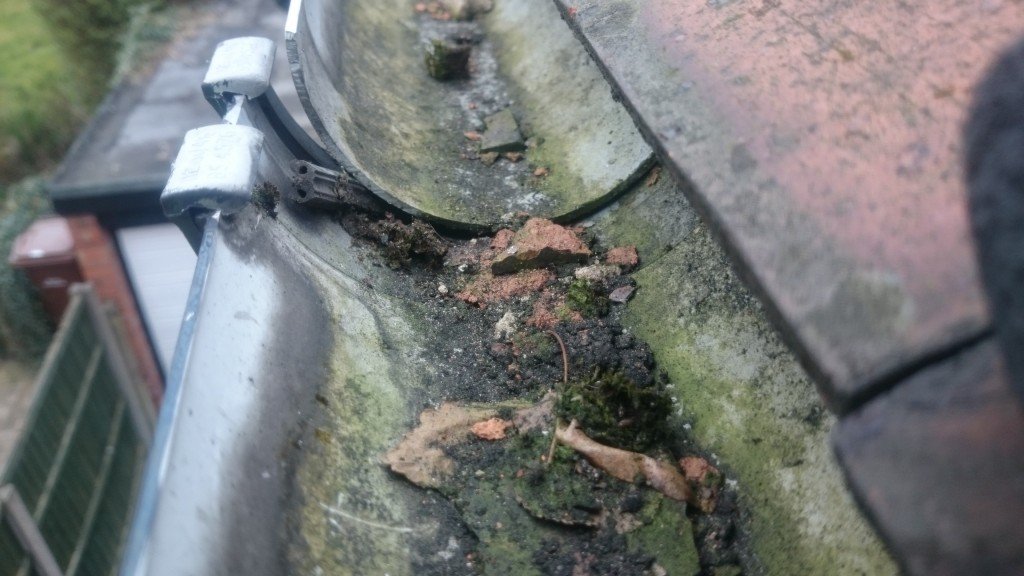
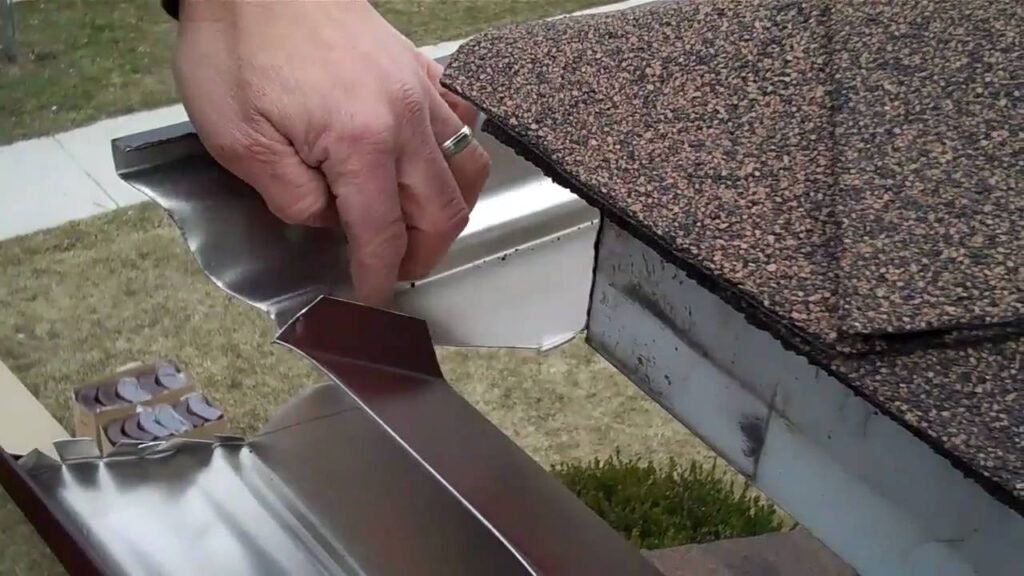
Before you start repairing your leaky gutter corners, gather the right tools and materials to ensure a safe, effective, and long-lasting fix. Here’s what you’ll need for an Auckland home, tailored for the city’s wet and coastal conditions.
Pro Tip: In Auckland’s coastal areas like West Harbour or Mission Bay, choose a sealant with rust inhibitors (e.g., Sika Sikaflex Pro) to protect metal gutters from salt corrosion. For older gutters, consider a rubberized sealant for its flexibility, as it can better handle joint movement caused by thermal expansion.
Fixing leaky gutter corners is a straightforward DIY task if you follow these steps. This guide is tailored for Auckland homeowners, ensuring your repair withstands the city’s wet, windy, and humid conditions.
Start by clearing debris and preparing the area for a strong seal:
Moisture will prevent the sealant from adhering properly, so the area must be completely dry:
Seal the corner joint to prevent water from escaping:
For larger cracks, gaps, or rusted areas, add extra protection:
Ensure your repair is effective and watertight:
Safety Note: Always use a stable ladder and have someone spot you while working at height. In Auckland’s high-wind zones, avoid working on windy days to reduce the risk of ladder accidents—wind speeds can reach 44m/s, making ladders unstable. Wear gloves to protect your hands from sharp edges, rust, and sealant chemicals, and use safety glasses to shield your eyes from debris.
Auckland’s climate and geography present unique challenges for gutter maintenance, making regular repairs and preventative measures essential. Here’s a deeper look at how the city’s weather affects your gutter corners and how to address these issues.
Auckland’s average annual rainfall of 1,200mm, combined with humidity levels of 70-80%, creates a perfect environment for moisture-related issues in gutters. Heavy rain (up to 150mm in a single day during winter storms) can overwhelm corner joints, especially if downpipes are blocked, causing water to back up and leak through seams. High humidity also accelerates the breakdown of sealant, as constant moisture prevents joints from fully drying out. Regular inspections and re-sealing every 2-3 years are key to staying ahead of leaks. For a project in Titirangi, we repaired a client’s gutter corners after a storm caused overflow due to heavy rain—adding a corner guard helped manage water flow and prevent future leaks.
Auckland is classified as a high-wind zone under NZS 3604, with wind speeds up to 44m/s, and some areas like the Waitakere Ranges or Orakei can experience stronger gusts. High winds can loosen gutter joins, pull corners apart, or cause debris to accumulate, leading to blockages and overflow. After a windy storm, inspect your gutter corners for signs of movement or damage, and tighten any loose joins. A client in Orakei we worked with had gutter corners that separated after a windy spring season—we re-secured the joins and sealed them, ensuring they could withstand future gusts.
In coastal Auckland suburbs like West Harbour, Mission Bay, or Takapuna, salt from sea air settles on gutters, forming white, crusty deposits that can accelerate corrosion, especially on aluminum or steel gutters. Over time, this salt buildup can lead to rust, pitting, or weakened corner joints, making leaks more likely. Using a rust-resistant sealant and treating rusted areas with a rust converter before sealing can mitigate this issue. For a project in West Harbour (near our office at 84B West Harbour Drive), we repaired a client’s gutter corners by removing salt buildup with a vinegar solution, treating rust, and sealing with a rust-inhibiting sealant, ensuring durability in the salty coastal environment.
In central Auckland suburbs like Mt Roskill, Grey Lynn, or Sandringham, urban pollution from traffic and industry can leave a layer of grime on gutters, attracting more debris and accelerating sealant breakdown. Pollen from trees, especially in spring, can also settle in gutters, contributing to blockages and overflow at the corners. Regular cleaning and inspections can prevent these issues. For a client in Mt Roskill, we cleaned their gutters after a dusty spring, removing pollen and pollution buildup that had caused their corner joints to leak due to overflow.
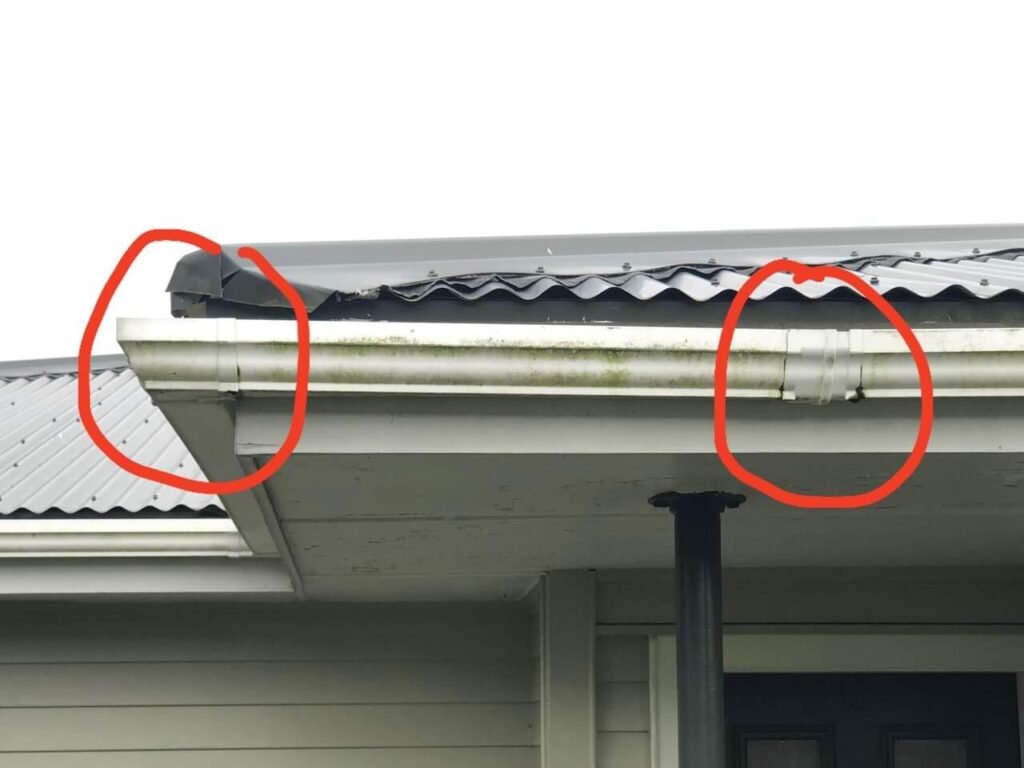
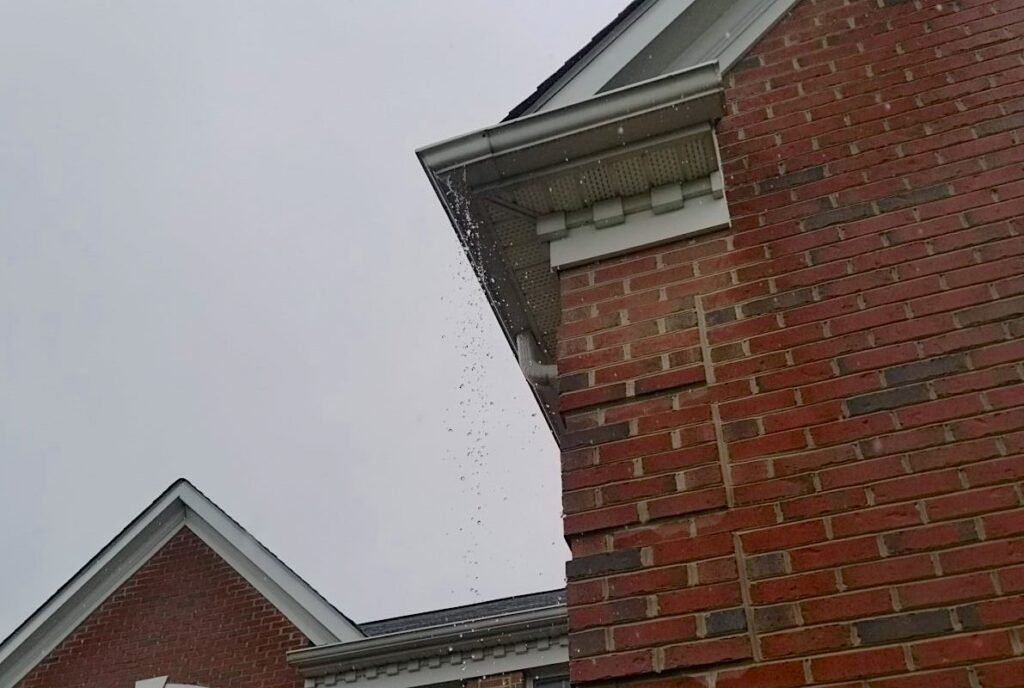
Fixing leaky gutter corners is important, but preventing them in the first place can save you time, money, and stress. Here are some preventative maintenance strategies tailored for Auckland homes.
Gutter guards are mesh or perforated covers that fit over your gutters, preventing leaves, twigs, and other debris from clogging the system. This reduces the risk of overflow at the corners, especially in treed areas like Titirangi or Albany. Gutter guards cost $5-$10 per meter at Bunnings and can be installed in a few hours. For a client in Albany, we installed gutter guards after repairing their leaky corners, significantly reducing debris buildup and preventing future overflow.
Clean your gutters at least twice a year—once in spring and once in autumn—to remove debris and prevent blockages that lead to overflow. In Auckland, where storms can bring down leaves and twigs, you may need to clean more often after major weather events. Use a ladder, gloves, and a bucket to clear debris, and check downpipes for blockages. In Papakura, we helped a client establish a regular cleaning schedule, which kept their gutters free of debris and prevented corner leaks during the rainy season.
Inspect your gutter corners annually for signs of wear, such as cracked sealant, rust, or small gaps. Re-seal the joints every 2-3 years, even if they’re not leaking, to maintain a watertight seal. Use a high-quality silicone or rubberized sealant for the best results. A client in Mt Eden we worked with avoided leaks by re-sealing their gutter corners every 2 years, keeping their system in top shape despite Auckland’s frequent rain.
Ensure your downpipes direct water away from your home’s foundation, ideally into a stormwater drain or a gravel-filled drainage area. If downpipes are too short or poorly positioned, water can back up and overflow at the corners. In St Heliers, we extended a client’s downpipe to a drainage area after repairing their gutter corners, ensuring water flowed away from the house and reducing stress on the joints.
With over 10 years of experience in gutter repairs, My Homes Construct Ltd has some expert tips to ensure your gutter corner repair is a success in Auckland’s challenging conditions.
Safety is critical when working on a ladder at height. Wear gloves, safety glasses, and sturdy shoes, and always have a buddy to hold the ladder and assist if needed. In Auckland’s high-wind zones, ladder accidents are a risk—check the weather forecast and avoid working on gusty days (wind speeds can reach 44m/s). A client in Papakura we worked with avoided a fall by having a family member spot them while repairing their gutter corners on a calm day.
Not all sealants work for every gutter type. For aluminum or steel gutters, use a silicone-based sealant with rust inhibitors (e.g., Sika Sikaflex Pro) to prevent corrosion, especially in coastal areas. For PVC gutters, a rubberized sealant like Bostik Roof & Gutter Silicone offers better flexibility and adhesion. In Mission Bay, we used a rust-inhibiting sealant for a client’s aluminum gutters, ensuring the repair held up against salt exposure.
Corner guards are metal or plastic caps that fit over gutter corners, directing water flow and reducing stress on the joints. They’re especially useful in Auckland, where heavy rain can overwhelm corner joints, causing leaks. You can find corner guards at Mitre 10 or Bunnings for $10-$20 each and install them with screws or adhesive. In Mission Bay, we installed corner guards for a client with high-flow gutters, significantly reducing wear on the joints and preventing leaks during heavy downpours.
To show how these steps and tips come together, here are two real-world examples of gutter corner repair projects we’ve completed at My Homes Construct Ltd.
A homeowner in West Harbour, near our office at 84B West Harbour Drive, contacted us about their aluminum gutters, which had rusty, leaky corners due to coastal salt exposure. The leaks were causing water to pool near their foundation, risking structural damage. We cleaned the corners with a wire brush, treated the rust with Resene Rust-Arrest, and sealed the joints with Sika Sikaflex Pro, a rust-inhibiting sealant. We also installed corner guards to manage water flow and extended the downpipe for better drainage. The repair cost $250, including materials and labor, and the client’s gutters have been leak-free for 2 years, even through Auckland’s wet winters.
A family in Titirangi had leaky gutter corners after a winter storm brought 120mm of rain in a single day, causing overflow from blocked downpipes. The leaks led to peeling paint on their fascia and mildew growth on their cladding. We cleared the downpipes, cleaned the gutter corners, and removed old sealant with a wire brush. After drying the area, we applied Bostik Roof & Gutter Silicone, smoothed it with a putty knife, and tested the repair with a hose. We also installed gutter guards to prevent future blockages. The project cost $300, and the client was thrilled to have their gutters watertight and their exterior protected from further damage.
While fixing leaky gutter corners is a manageable DIY task for many Auckland homeowners, some situations call for professional help. Here’s when to contact the experts at My Homes Construct Ltd.
If your gutters have multiple leaks, extensive rust, or are sagging, the damage may be too severe for a simple repair. Rusty or sagging gutters often indicate structural issues or the need for replacement, which requires specialized tools and expertise. Replacement costs in Auckland typically range from $2,000 to $5,000 for a standard home. In West Harbour, we replaced a client’s rusted gutters after failed DIY repairs, ensuring their home was protected from water damage with a new, durable system.
If leaking gutter corners have caused water damage to your soffits, fascia, or cladding, a professional can assess the extent of the damage and repair both the gutters and the affected areas. Water damage can lead to mold growth in Auckland’s humid climate, costing $2,000-$5,000 to remediate, plus additional repair costs for damaged materials. In St Heliers, we repaired a client’s gutter corners and replaced their water-damaged soffits, preventing further deterioration and mold growth that could have affected their family’s health.
If you don’t have a stable ladder, the right sealant, or the time to complete the repair, a professional can get the job done quickly and safely. At My Homes Construct Ltd, we offer affordable gutter repair services, often completing corner repairs in under 2 hours for $150-$300. A client in Papakura hired us to fix their gutter corners due to a busy schedule—they were thrilled with the fast, hassle-free service and the peace of mind that came with a professional repair.
Here are answers to more frequently asked questions, formatted for voice search and NLP optimization.
Inspect your gutter corners at least twice a year—once in spring and once in autumn—especially after heavy rain or storms. Auckland’s wet climate can accelerate wear, so regular checks help catch leaks early and prevent water damage.
Use a silicone-based or rubberized sealant like Sika Sikaflex or Bostik Roof & Gutter Silicone. These are waterproof, flexible, and UV-resistant, ideal for Auckland’s weather. In coastal areas like West Harbour, choose a sealant with rust inhibitors to protect metal gutters.
No, the area must be completely dry for the sealant to adhere properly. Wait for a dry day or use a tarp to keep the area dry while working. Auckland’s frequent rain (up to 150mm in a single storm) can make this tricky, so plan ahead and check the forecast.
Clean your gutters twice a year to remove debris, inspect and re-seal joints every 2-3 years, and install gutter guards to prevent blockages. Ensure downpipes direct water away from your foundation, and check for rust or damage after storms, especially in coastal areas.
A DIY repair costs $50-$70 for materials (sealant, patch tape, rust converter). Professional repairs in Auckland typically cost $150-$300, depending on the extent of the damage. At My Homes Construct Ltd, we offer competitive rates—contact us for a free quote!
Repairing leaky gutter corners is a simple yet essential task to protect your Auckland home from water damage, maintain your roofline, and preserve your property’s value. By following this step-by-step guide, you can fix leaks, prevent future issues, and keep your gutters in top shape, even in Auckland’s challenging weather. With preventative maintenance and regular inspections, you can avoid costly repairs and ensure your home stays dry and damage-free for years to come.
Want to fix your gutter corners fast and properly?
📞 Call My Homes Construct Ltd today at +64 22 315 8987.
📍 We’re based in West Harbour, Auckland, and proudly serve the entire region with expert gutter services!
Let’s keep your home dry and damage-free—contact us today!
WhatsApp us